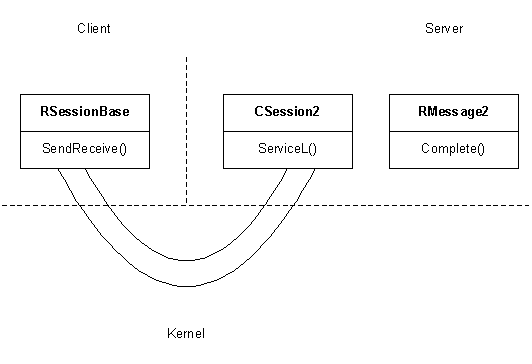Sessions and requests
Describes communication between the client and the server in the client-server framework.
Communication between client and server is represented by a session ; this is initiated by the client. A client thread may have several sessions with a server. A session can also be shared by all the client threads in a process, if supported by the server, and also by all threads across all processes, again if supported by the server.
Sessions are maintained by the Kernel and the important points are:
-
The client has an RSessionBase handle to the session.
-
The server uses a CSession2 -derived class to represent the session.
-
A session may be sharable between the threads in the client process, between all threads across all processes, or it can be restricted to the thread connecting to the server.
If a call to the client interface requires a service from the server, the client interface must set up and send a message. The message has a 32-bit operation code to identify the request, and up to four 32-bit parameters. The message is encapsulated within a TIpcArgs object. The process can be summarised as follows:
-
The client sends the message to the server using RSessionBase::SendReceive() . This call eventually returns with the completion code.
-
The Kernel packages the operation code and parameters and delivers an RMessage2 to the server.
-
The server delivers the message to the appropriate CSession2 object, which deals with the request. The request is handled by CSession2::ServiceL() . This is defined as pure virtual in CSession2 , and is implemented by the class derived from CSession2 . When the session has finished dealing with the request, it calls RMessage2::Complete() to indicate that the service has been performed and to return a 32-bit result to the client - this is returned from the SendReceive() .
The client-server framework also supports the sending of requests asynchronously to the server.
The following diagram illustrates this:
A server can support multiple connections from a client in a number of distinct ways:
-
The client may have a number of concurrent sessions with a particular server.
-
Each session is independent of any other within the client thread; Connect() must be called to initialise each new connection.
-
The client may create a number of subsessions within a single session.
-
Each client subsession corresponds to a subsession object in the server. The client subsession contains a handle to this subsession object. All communication is via the owning session; the handle is used to match up corresponding client subsessions and subsession objects.
-
Subsessions use fewer Kernel resources than sessions, although they are slightly more complex to use.
A server can support the creation of sharable sessions allowing either all the threads in a client process to share a single session, or allowing all threads across all processes to share a single session. The important points are:
Copyright ©2010 Nokia Corporation and/or its subsidiary(-ies).
All rights
reserved. Unless otherwise stated, these materials are provided under the terms of the Eclipse Public License
v1.0.
